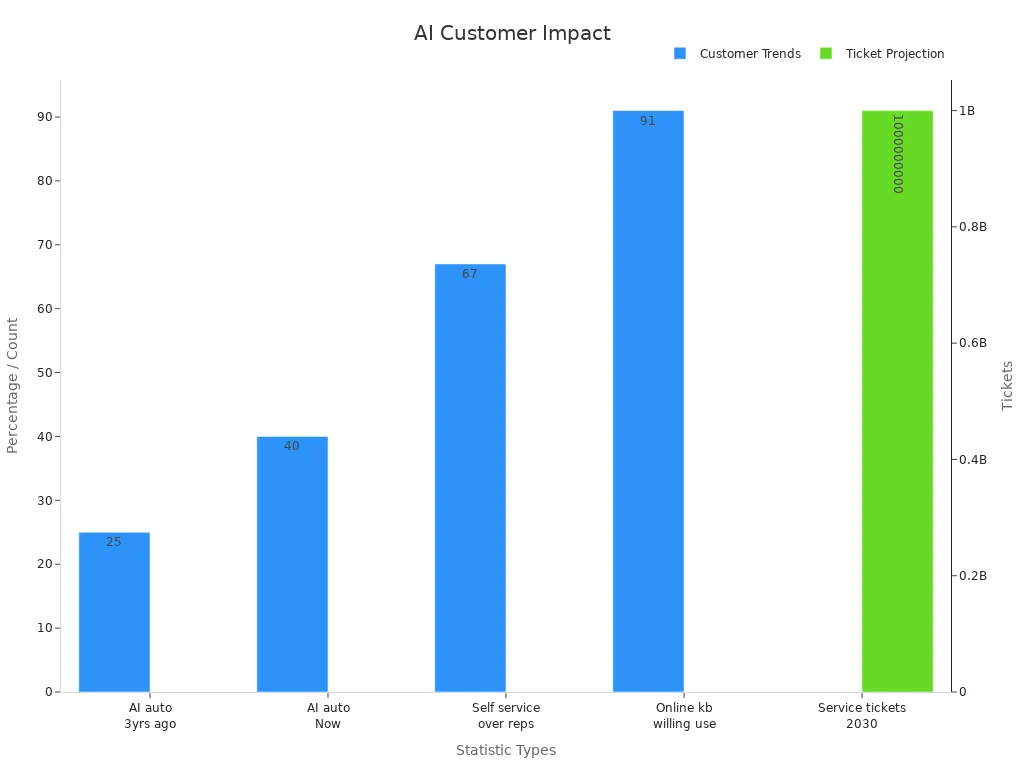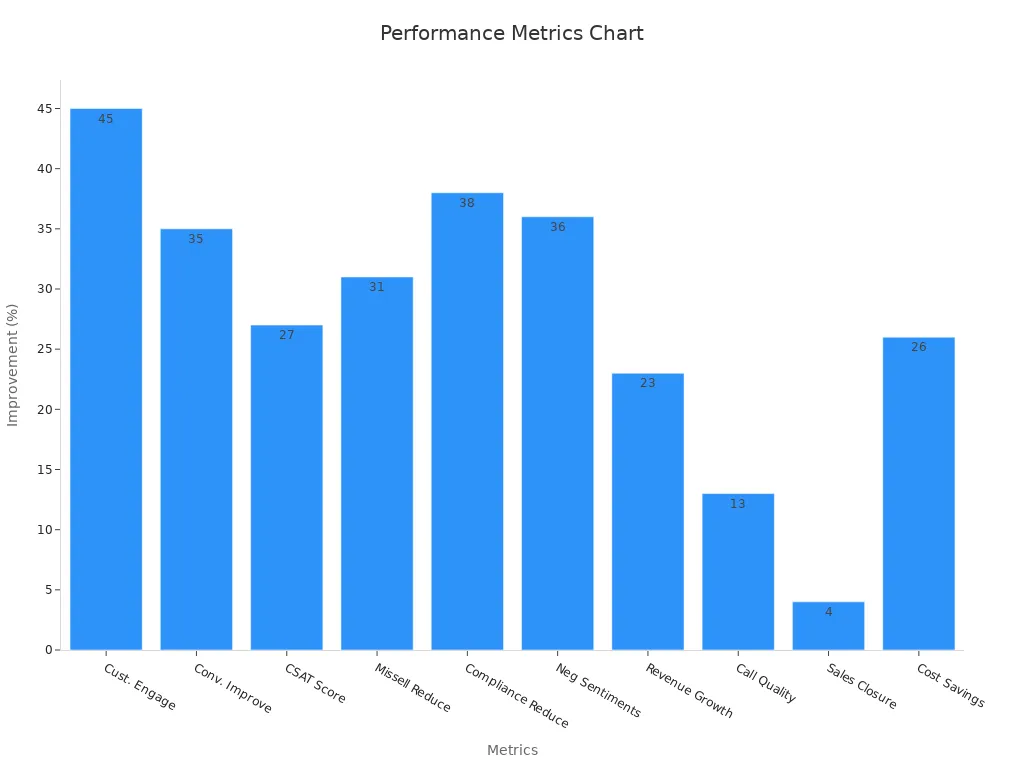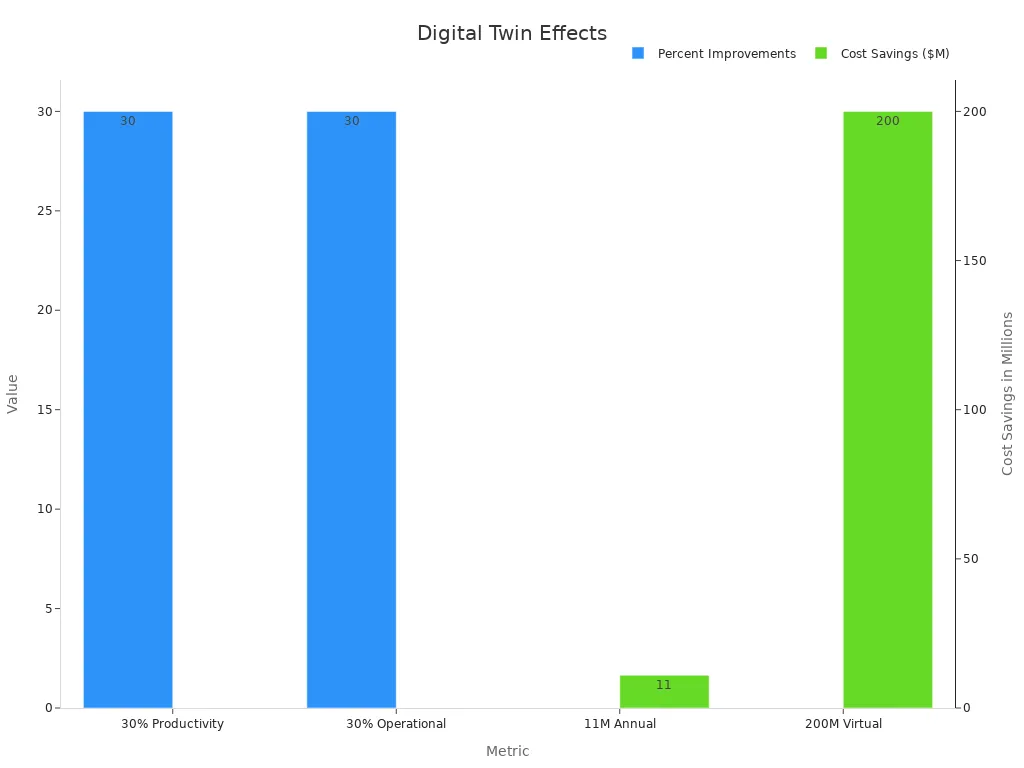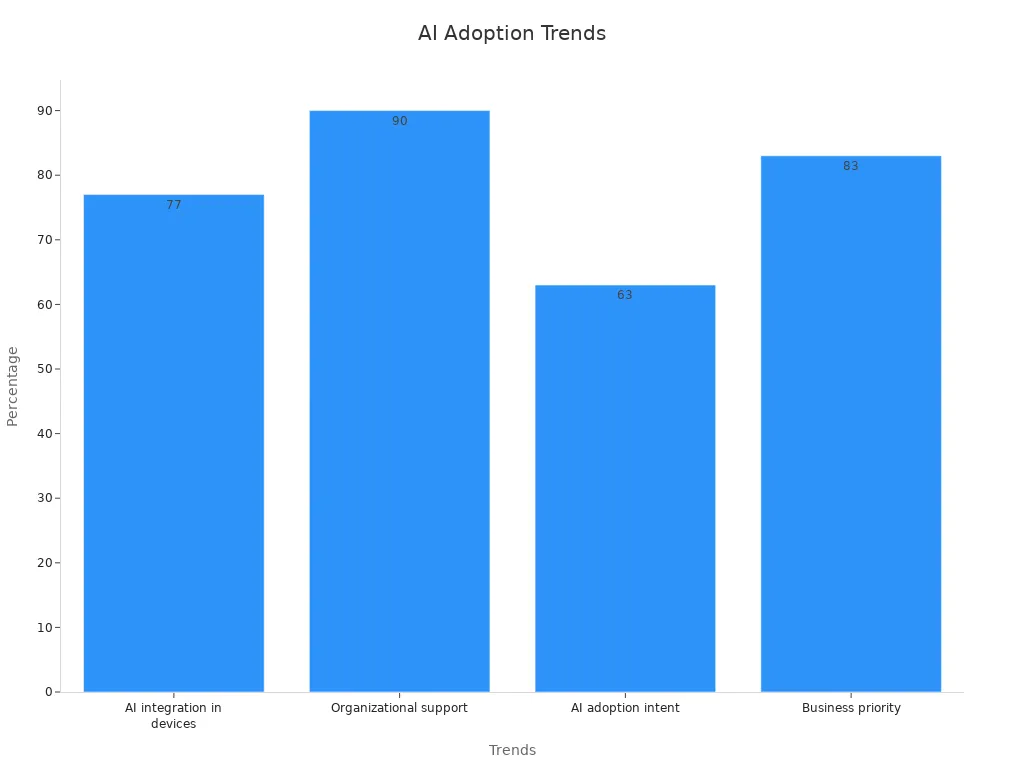Future Trends in AI-First Customer Experience Content

AI-first customer experience now changes how businesses compete. Companies get real benefits as AI becomes a main strategy. A 2024 study shows leaders like Netflix and JPMorgan Chase use AI to improve customer touchpoints. The IBM 2025 report connects strong AI use to happier customers and agents. Businesses that follow new AI trends get faster, more personal, and smarter service.
Statistic Description | Value / Projection |
|---|---|
AI automation of customer interactions (3 years ago) | 25% |
AI automation of customer interactions (current) | 40% |
Customers preferring self-service over representatives | 67% |
Customers willing to use an online knowledge base | 91% |
Projected service tickets raised automatically by 2030 | 1 billion (by customer-owned bots) |

Future trends in AI-first customer experience help companies win. Companies that use AI now stand out in a changing market.
Key Takeaways
AI-first customer experience lets companies give faster and smarter service. It also makes service more personal. This helps customers feel happy and stay loyal to the company.
Hyper-personalization uses AI to make offers and messages just for each customer. This helps customers get more interested and come back again.
Emotional AI can find out how customers feel right away. This helps lower complaints and makes customers more happy and loyal.
Generative AI and multimodal AI help make better content and customer talks. They use text, voice, and pictures together for smooth support.
Good data privacy and trust rules are very important when using AI. These rules help keep customers safe and loyal.
Future Trends in AI CX
Businesses now think Future Trends in AI-first customer experience are very important for growth. These trends change how companies talk to customers and help them stay loyal. Leaders look at three big things: hyper-personalization, emotional AI, and generative AI. Each trend gives new ways to check success and give more value.
Hyper-Personalization
Hyper-personalization uses AI to make special experiences for each customer. Companies look at what people buy, what they post, and what they say. This helps them guess what customers want next. Starbucks uses AI to send offers that make people buy more and come back. Studies say 79% of customers want things made just for them. AI tools now check Customer Lifetime Value (CLV) with more details. They use numbers and stories from real people. This helps brands make better bonds and get more people involved.
Note: AI-driven personalization also makes Net Promoter Score (NPS) and Customer Satisfaction Score (CSAT) better by sending follow-ups and making wait times shorter.
Emotional AI
Emotional AI helps companies know how customers feel every time they talk. AI looks at voices, words, and actions to find upset customers and give ideas to help. Studies say keeping 5% more customers can make profits go up by 95%. Emotional AI makes complaints go down by 20% and makes NPS go up by more than 20 points. Brands using emotional AI get more loyal customers and fewer bad reviews. Real-time dashboards help teams fix problems fast and keep people happy.
Metric/Analysis | Impact/Result |
|---|---|
25% to 95% increase in profits | |
20% drop in customer complaints | Improved customer satisfaction |
Higher customer loyalty and advocacy | |
86% willing to pay more for excellent CX | Shows value of emotionally aware engagement |
Generative AI
Generative AI changes how companies make content and solve customer problems. It can write emails, answer questions, and suggest new things to buy. Verizon used generative AI to answer almost all customer questions. This made sales go up by 40%. ING helped 20% more customers in seven weeks with conversational AI. United Airlines made customers 6% happier after using generative AI for flight updates. These results show generative AI saves time and helps companies serve more people and keep them happy.
Company | Measurable Outcomes |
|---|---|
Verizon | 40% increase in sales; AI answers 95% of queries; enables hyper-personalization |
ING | 20% more customers served in 7 weeks; improved satisfaction and loyalty |
United Airlines | 6% increase in customer satisfaction; better flight notifications |
Future Trends in AI-first customer experience will keep bringing new ideas. Companies that spend money on these things will get better results and stronger customer bonds.
Multimodal AI

Multimodal AI changes how companies talk to customers. It uses text, voice, and pictures together. This makes customer service smarter and more personal. Many businesses now use multimodal AI to help people better. It helps every customer feel noticed and understood.
Contextual Interactions
Contextual interactions use multimodal AI to know what customers want right away. The system listens to voices, reads words, and looks at pictures. This helps it give the best answer fast. Banks and insurance companies use it for help with money and support. Stores use it to guide shoppers and answer questions quickly. The table below shows how different businesses get better with this technology:
Industry Sector | Performance Improvements by Multimodal AI | Examples and Impact |
|---|---|---|
BFSI (Banking, Financial Services, Insurance) | Smoother workflows and real-time insights improve customer interactions and transaction support. | Interface.ai and Sphere AI agents support customers and staff in real time. |
Retail & E-commerce | Personalized shopping journeys and instant inquiry solutions boost support efficiency. | AI chatbots and assistants handle text, image, and voice data for better service. |
IT & Telecommunications | Smart applications learn and predict, improving decision-making and automating tasks. | Growth in smart apps that automate complex tasks across platforms. |
Multimodal AI helps more people get involved with companies. It makes customer happiness scores go up by 27%. It also helps companies get fewer bad reviews and save money. The chart below shows these good changes:

Systems check how well they do by using precision, recall, and F1 scores. Many systems get 80% in each score. This means they understand customers well and answer correctly.
Seamless Experiences
Seamless experiences mean customers get great service every time. It does not matter if they call, chat, email, or use an app. Companies use multimodal AI to connect all ways people reach out. This means customers do not have to repeat their problems. New studies show how companies do this:
They make rules and goals the same everywhere for good service.
They use CRM systems and automatic tools to help and personalize.
They keep messages the same on websites, stores, and phones.
They watch feedback from surveys and social media to fix problems fast.
They talk to customers in special ways and change offers for each group.
They help teams work together so the customer journey is smooth.
These steps help companies earn trust and keep customers loyal. People like getting the same good service each time. This makes them want to come back. Multimodal AI connects all the data and ways to talk. It makes every customer feel special and makes things easy.
AI Agents Evolution
Multi-Agent Systems
Multi-agent systems change how companies help customers with hard needs. These systems use many AI agents that work as a team. Each agent does a special job. Some answer easy questions. Others fix hard problems or check on customers later. Working together makes service faster and more personal.
Companies get big benefits from this. Workers do not waste time on boring jobs. AI agents do those tasks instead. A survey says workers lose over 60% of their day on routine work. Multi-agent systems let them work on important things. These systems also help find fraud and train workers. They can make learning plans for each worker.
The table below shows how multi-agent systems help businesses:
Evidence Aspect | Details |
|---|---|
Adoption Statistics | 25% of enterprises use generative AI agents by 2025; 50% by 2027; over 60% embed agentic architectures |
Efficiency Improvements | Specialized agents automate complex workflows, boosting productivity and speed |
Decision-Making Enhancement | Collaborative agents provide deeper insights and more accurate analyses |
Real-World Applications | Customer support, supply chain optimization, real-time data processing |
Enterprise Platforms | PwC’s Agent OS, IBM Watson Orchestrate, Microsoft Copilot support multi-agent deployment |
Multi-agent systems are easy to grow. Companies can add new agents without changing everything.
Virtual Assistants
Virtual assistants are now very important in customer service. They answer questions, fix problems, and help people in many languages. In 2024, the AI agents market was $12.06 billion. By 2030, experts think it will be $47.82 billion. The growth rate is 25.8%. These assistants help companies cut handle times by 27%. They do this by sending tickets to the right person and giving fast answers.

Virtual assistants work in 135 languages. They help companies talk to more people around the world. Media and entertainment companies use these tools the most for digital change. Asia Pacific grows the fastest because it has many people and strong AI spending.
Companies using virtual assistants get happier customers and faster help. These tools help brands stay ahead in a fast-moving world.
Assistive Search
Knowledge Work Enhancement
Assistive search tools help people find answers fast. These tools use AI to know what users want. They suggest answers, show key facts, and sort data. Many companies use assistive search to help workers finish jobs faster. In healthcare, staff use these tools to manage records and find treatment rules. This saves time and cuts down on mistakes.
A new study looked at workers using assistive technology. It found people with these tools were 13.2 percentage points more likely to keep their jobs after four years. Jobs with more assistive tech grew faster. Reviews say assistive search makes job performance and self-esteem better. Workers feel more sure when they can find answers alone. In hospitals, staff say assistive search helps workflow and lowers stress. But some advanced tools are still hard to use. Companies need better training and new systems to get the most from these tools.
Tip: Companies that buy easy assistive search tools help teams work smarter and faster.
Real-Time Support
Real-time support changes how customers get help. AI search and chatbots answer questions right away. This cuts wait times and keeps customers happy. Most people want fast answers. In fact, 90% of customers say "immediate" response is important. For 60%, "immediate" means ten minutes or less.
Aspect | Evidence Summary |
|---|---|
Customer Expectations | 90% of customers rate an "immediate" response as important; 60% define "immediate" as 10 minutes or less. |
Chatbot Advantage | Provides immediate, 24/7 responses, significantly reducing wait times for common queries. |
Live Chat Advantage | Handles complex issues that chatbots cannot resolve, providing in-depth support. |
Combined Use of Chatbots & Live Chat | Chatbots handle initial queries instantly; complex issues are escalated to live agents, reducing overall lag time. |
Automation & Software | Customer service software automates initial replies and centralizes queries, speeding up response times overall. |
Companies use both chatbots and live agents. Chatbots answer easy questions. Live agents fix harder problems. This teamwork gives customers quick and full support. Automation tools also help by sending instant replies and sorting requests. So, customers get help without long waits.
Omnichannel Integration
Unified Data
Unified data is the main part of a good omnichannel plan. When companies connect data from all channels, they see the whole customer journey. This helps teams guess what customers want and send the right message. Using unified data gives businesses many benefits.
Multi-touch attribution gives credit to every customer action, not just the last one.
Customer Lifetime Value (CLTV) shows which groups are most important.
Unified data lets companies personalize at scale and predict demand better.
Teams can spend more time on planning because data is already connected.
The table below shows how unified data helps business results:
Benefit Description | Statistic Comparison / Value |
|---|---|
Customer retention rate (strong vs weak) | |
Purchase frequency (omnichannel vs single) | 250% higher |
Average order value increase | 13% more per order |
Purchase rate using 3+ channels vs single | 287% higher |
Lifetime value of omnichannel shoppers | 30% higher |
Year-over-year revenue increase (strong vs weak) | 9.5% vs. 3.4% |
Year-over-year decrease in cost per contact (strong vs weak) | 7.5% vs. 0.2% |
Percentage of companies storing data across channels (strong vs weak) | 77% vs. 48% |
Companies use analytics and AI tools to check how campaigns do, count conversions, and test ideas. Product Information Management (PIM) and Product Experience Management (PXM) systems help keep product data the same everywhere. This makes it easier to personalize and keep info correct.
Consistent Touchpoints
Consistent touchpoints help build trust and loyalty. Customers want the same experience online, in stores, or in apps. When companies give steady service and messages, customers feel important and understood.
Studies show that giving the same experience everywhere makes people happier and trust more.
Happy customers are twice as likely to come back and tell friends.
A UK store sold more by making its website match the store, using better words and a friendly style.
Companies use journey data to find and fix weak spots, making every place and channel better.
Being consistent in every meeting with customers lowers the chance of bad feelings from rare problems and makes loyalty stronger. Customers know what will happen and feel sure about picking the brand again.
By using unified data and keeping touchpoints the same, companies make smooth journeys that bring customers back.
Digital Twins & Quantum AI

Personalized Experiences
Digital twins use AI to make models of customers. These models help companies know what each person likes. Companies can pretend to talk to customers using these models. This helps them make special experiences for everyone. For example, companies can try new offers with digital twins first. They do this before showing them to real customers. This helps brands find the best ways to keep people loyal and interested.
A table below shows how digital twins help companies connect with customers and do better in business:
Performance Metric | Description / Example |
|---|---|
Customer Engagement Increase | 15% more people join campaigns on all channels |
Predictive Churn Probability | 78% chance of finding customers who might leave |
Customer Lifetime Value (LTV) | Gets better with special marketing for each person |
Customer Acquisition Cost (CAC) | Goes down with smart ads and better marketing |
Hyper-Personalization | N=1 personalization means ads fit each customer’s likes |
Loyalty Program Optimization | Rewards change to match what each customer wants |
Segment Twins | AI models for groups help companies send the right messages |
Singular Twins | AI copies of single customers help with personal ads and keeping them |
Digital twins also help companies find hidden problems by looking at live data. They do easy jobs by themselves. This lets support teams spend more time helping people in a friendly way. Customers get answers faster and feel happier.
Predictive Insights
Digital twins and quantum AI help companies guess what customers will do next. They run pretend tests to see what might happen. This saves money and stops mistakes. For example, an insurance company saved $11 million every year. They also worked 30% faster after using digital twins to fix their work steps.

In many jobs, digital twins helped cut costs by up to 30%. Pretend tests saved about $200 million by checking products before selling them. Companies use these ideas to set better prices and make special deals. They also make loyalty programs that fit what each customer wants. Because of this, businesses get more people to join, keep more customers, and make more money.
Data & Ethics
Privacy Compliance
AI-first customer experience needs strong privacy rules. Companies must protect customer data and follow the law. They use fairness, accountability, and transparency to guide them. These ideas help stop bias and keep personal info safe. Companies use less data and store it safely to lower risks. Automated tools help keep data safe and follow the rules.
Companies must tell people how they use AI and data. Simple privacy policies and explainable AI help customers know what happens to their info.
Many laws tell companies how to handle privacy with AI. The table below lists important rules and what they require:
Compliance Report / Regulation | Key Privacy Considerations in AI-Driven Customer Engagement |
|---|---|
FTC Guidelines | Stop unfair AI actions; make sure AI decisions are correct. |
Fair Credit Reporting Act (FCRA) | Make sure credit data is right; let people fix mistakes. |
CCPA & CPRA | Be open, let people opt out, delete data, and share AI use. |
BIPA | Get written permission before using biometric data in AI. |
GDPR | Ask for consent, be clear, use less data, and explain AI choices. |
EU AI Act | Protect rights, be open, and keep data private in AI. |
To follow these rules, companies check if data is correct and useful. They look for accuracy, completeness, consistency, timeliness, and relevance. They also use NIST AI Governance and FAIR Principles to keep data safe and helpful.
Trust Building
Trust is very important for customer loyalty with AI. Customers want to know their data is used the right way. When companies are fair, open, and responsible, customers feel safe. Trust grows when companies use explainable AI and let people control their data.
Trust in the company and its AI makes customers more loyal.
Engaged customers build strong bonds, not just buy things.
AI tools like chatbots and ID checks make service safer and better, so people use them more.
Companies that build trust get more loyal customers and better results. They must keep making their AI fair and open.
To build trust, companies do these things:
Give clear jobs for AI checks and do audits often.
Use different data to stop bias.
Talk openly about AI choices and data use.
Let people say no to automated choices.
By focusing on privacy and trust, companies make every customer feel safe and happy. This helps brands stand out and keeps people coming back.
Future Trends in AI-first customer experience help companies do better. Companies get happier customers, faster help, and more loyal buyers. Studies say 90% of companies use AI to stay ahead. Also, 83% say AI is very important for their plans. Companies using AI-first ideas see up to 20% more happy customers and 25% more people joining in.

Trend / Metric | Numerical Outcome | Description |
|---|---|---|
AI integration in devices | 77% of devices have AI | Widespread AI presence in daily tech |
Productivity impact | 40% improvement | AI boosts employee productivity |
Economic contribution | $15.7 trillion by 2030 | AI’s global economic impact |
To win, leaders should buy AI tools and teach their teams. They need to check results, keep data safe, and earn trust. As AI changes, companies that learn and grow will lead the way in customer experience.
FAQ
What is AI-first customer experience content?
AI-first customer experience content uses artificial intelligence to make and share information. Companies use AI to send special messages and answer questions. AI also helps make service better and faster. This way, brands can help customers quickly and give them what they need.
How does hyper-personalization improve customer loyalty?
Hyper-personalization uses AI to look at what customers do and like. Brands send messages and offers that fit each person. Customers feel special and noticed. This makes them want to come back and buy again.
Why do companies need to focus on data privacy with AI?
Data privacy keeps customer information safe. Companies must follow rules and earn trust. AI works with lots of data every day. Good privacy rules protect data and help customers feel safe.
What are digital twins in customer experience?
Digital twins are online copies of customers. Companies use these models to guess what people want and try new ideas. Digital twins help brands give each customer a better and more personal experience.
Can AI-powered chatbots replace human agents?
AI-powered chatbots answer easy questions fast. They work all the time, day and night. Human agents fix hard problems and show care. Companies use both so customers get quick and full help.
See Also
Exploring Key B2B Content Marketing Trends For 2024
How To Excel As A Content Marketing Strategist In 2024
Data-Driven Insights Into 2024 Blog Trends Affecting Marketing
Five Effective Ways To Boost Healthcare Content Marketing Results
Step-By-Step Guide To Fast Content Creation With Latest Updates

